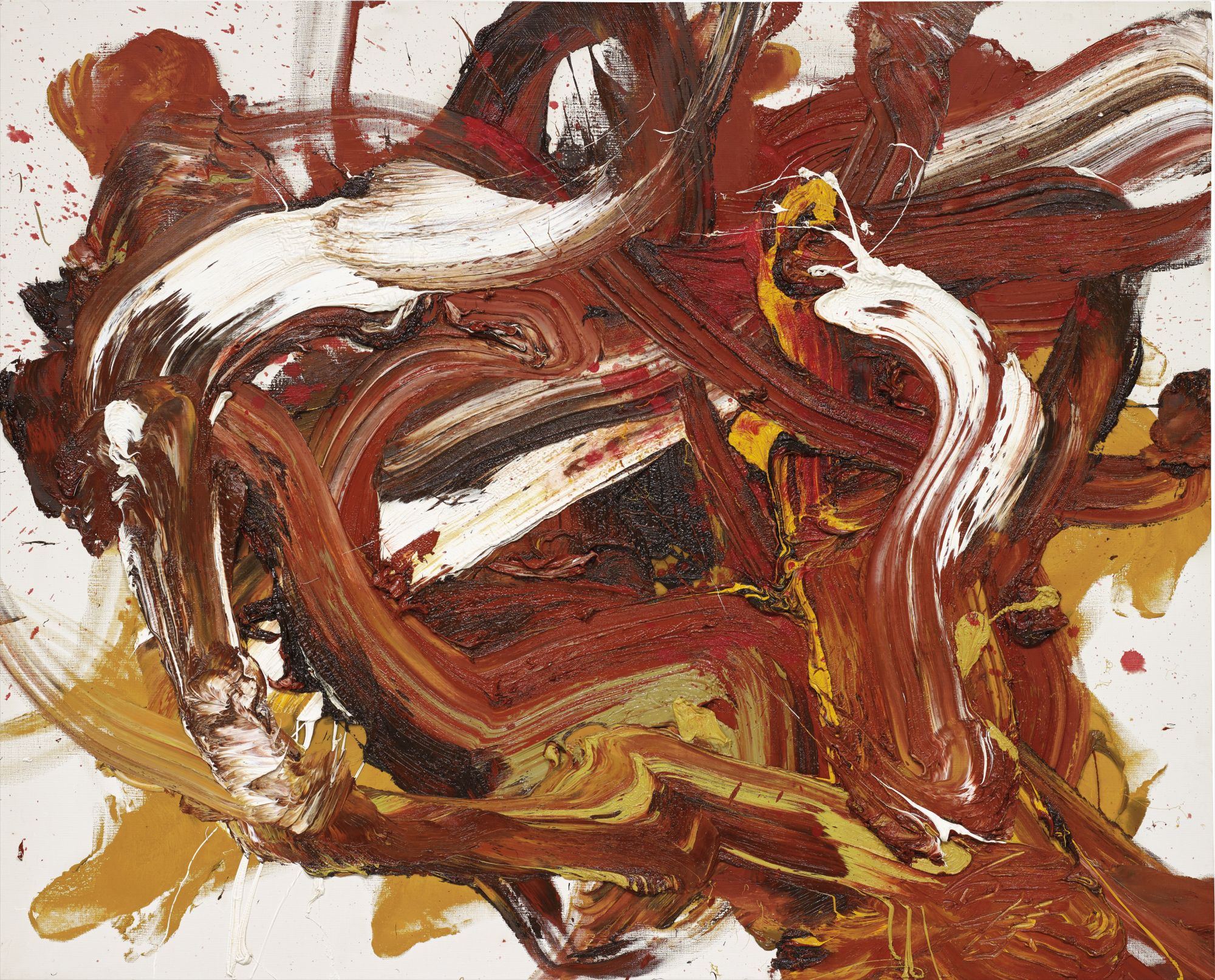

28Ο
Kazuo Shiraga
Zuisouhen
oil on canvas
130 x 160 cm (51 1/8 x 62 7/8 in.)
Signed and inscribed on the reverse in Kanji.
Full-Cataloguing
Kazuo Shiraga was one of the founders of the Gutai Art movement, developed in 1954 in the wake of the Second World War in Japan. Gutai artists favoured freedom of expression and creativity above anything else, dismantling the regime of total unity imposed during the war. For these artists, art was a playful means that freed audiences from ideologies and social conventions. As a Gutai pioneer, Yoshihara Jiro’s dictum was: 'Do what no one has done before!' (Yoshihara Jiro, 'Gutai Gurupu no 10 nen: Sono ichi' [10 years of the Gutai Group: Part One], Bijutsu January 38 (March 1963), pp.3-5). Executed in 1986, Zuisouhen’s mesmerising dynamism and unrestrained energy is an outstanding example of Kazuo Shiraga's persistent engagement with action painting as a powerful means of artistic expression. Thick twirls of red, white, yellow and black converge in the middle of the composition, maintaining their unique tonalities while harmoniously melting into one single hue of colour. The dense strokes of paint convey a material dimensionality and vigour. The red pigments can be seen both as abstract forms and as images of blood.
Shiraga epitomised the Gutai’s spirit of playfulness, he completely rejected the traditional medium of painting with brushes, and sought progressive ways to make art. Fastening a rope above the painting he glided across the canvas in vigorous movements, spreading thick mounds of paint with his feet on the surface. In doing this, Shiraga fully mastered the canvas, by immersing himself into the work. Shiraga explained: 'I want to paint as though rushing around on a battlefield, exerting myself to collapse from exhaustion.' (Yoshihara Jiro quoted in: Exh. Cat., New York, McCaffrey Fine Art, Kazuo Shiraga, 2009, p. 59). The motif of 'exhaustion' and violence, here expressed with the imagery of a 'battlefield', are references to the Matsuri festivals in Japan – namely Buddhist purification festivals intended to renew ties with divinities and nature, and also bonds between individuals in a community. The festivals are pervaded by a Dionysian chaotic energy, in which humans must appease and entertain the deities. As Shiraga described, Matsuri provided a primordial experience that let him develop a form of art able to present both beauty and destruction. 'My art needs not just beauty, but something horrible. All of my works more or less express some sort of gruesomeness'(K. Shiraga, quoted in Exh. Cat., Dominique Levy Gallery, New York, 2015, p. 20).
Shiraga’s radical and aesthetically poignant 'active paintings' were ground-breaking in the history of Japanese avant-garde art. Shiraga’s artistic importance not only in Japan, but also in post-war Western art, has long been underestimated. Only recently Shiraga and the Gutai group have been truly appreciated in the outstanding exhibition Gutai: Splendid Playground at the Guggenheim Museum in New York in 2013. Shiraga stands as one of Japan’s most influential artists; he continued his action paintings until his death in 2008.
Shiraga epitomised the Gutai’s spirit of playfulness, he completely rejected the traditional medium of painting with brushes, and sought progressive ways to make art. Fastening a rope above the painting he glided across the canvas in vigorous movements, spreading thick mounds of paint with his feet on the surface. In doing this, Shiraga fully mastered the canvas, by immersing himself into the work. Shiraga explained: 'I want to paint as though rushing around on a battlefield, exerting myself to collapse from exhaustion.' (Yoshihara Jiro quoted in: Exh. Cat., New York, McCaffrey Fine Art, Kazuo Shiraga, 2009, p. 59). The motif of 'exhaustion' and violence, here expressed with the imagery of a 'battlefield', are references to the Matsuri festivals in Japan – namely Buddhist purification festivals intended to renew ties with divinities and nature, and also bonds between individuals in a community. The festivals are pervaded by a Dionysian chaotic energy, in which humans must appease and entertain the deities. As Shiraga described, Matsuri provided a primordial experience that let him develop a form of art able to present both beauty and destruction. 'My art needs not just beauty, but something horrible. All of my works more or less express some sort of gruesomeness'(K. Shiraga, quoted in Exh. Cat., Dominique Levy Gallery, New York, 2015, p. 20).
Shiraga’s radical and aesthetically poignant 'active paintings' were ground-breaking in the history of Japanese avant-garde art. Shiraga’s artistic importance not only in Japan, but also in post-war Western art, has long been underestimated. Only recently Shiraga and the Gutai group have been truly appreciated in the outstanding exhibition Gutai: Splendid Playground at the Guggenheim Museum in New York in 2013. Shiraga stands as one of Japan’s most influential artists; he continued his action paintings until his death in 2008.